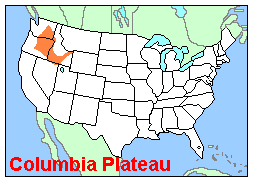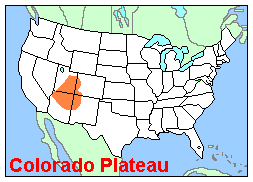America's Volcanic Past -
The American West
| "Though few people in the United States may actually experience an erupting volcano, the evidence for earlier volcanism is preserved in many rocks of North America. Features seen in volcanic rocks only hours old are also present in ancient volcanic rocks, both at the surface and buried beneath younger deposits." -- Excerpt from: Brantley, 1994 |

Map - Potentially Active Volcanoes of the
Western USA
[27K,InlineGIF]

Volcanic Highlights and Features:
[This list is just a sample of
various American West volcanic features or events and is by no means inclusive.]
- The American West
- America's Volcanic past - The American West
The American West is one of the most unusual volcanic provinces on Earth. It is an extraordinary wide region of contemporaneous volcanism, stretching 1,800 kilometers (approximately 1,120 miles) from east of the Rocky Mountains to the west of the Cascades. It encompasses a very wide variety of volcanic landforms and diverse rock compositions, with the only consistency being small basalt fields that are scattered throughout the whole vast region. Intriguingly, except for the Cascadian segment, there is no
currently active plate subduction to drive the volcanism, although there are hot spots, persistently "leaky" faults, and rifting.

Pacific Mountain System Sierra Nevadas Cascade Range Region
This region is one of the most geologically
young and tectonically active in North America. The
generally rugged, mountainous landscape of this
province provides evidence of ongoing
mountain-building.
The Pacific Mountain System straddles the
boundaries between several of Earth's moving
plates -- the source of the monumental forces
required to build the sweeping arc of mountains that
extends from Alaska to the southern reaches of
South America. This province includes the active and sometimes deadly volcanoes of the
Cascade Range and the young, steep mountains of the Pacific Border and the Sierra Nevada.

Columbia Plateau Region
The Columbia Plateau province is
enveloped by one of the worlds largest
accumulations of lava. Over 500,000 square kilometers of
the Earth's surface is covered by it. The topography
here is dominated by geologically young lava flows
that inundated the countryside with amazing speed,
all within the last 17 million years.
Over 170,000 cubic kilometers of basaltic lava,
known as the Columbia River basalts, covers the western part of the province. These
tremendous flows erupted between 17-6 million years ago. Most of the lava flooded out in
the first 1.5 million years -- an extraordinarily short time for such an outpouring of molten
rock.
It is difficult to conceive of the enormity
of these eruptions. Basaltic lava erupts at no
less than about 1,100 degrees C. Basalt is a very fluid
lava; it is likely that tongues of lava advanced
at an average of 5 kilometers per hour - faster
than most animals can run. Whatever
topography was present prior to the Columbia
River Basalt eruptions was buried and
smoothed over by flow upon flow of lava.
Over 300 high-volume individual lava
flows have been identified, along with
countless smaller flows. Numerous linear
vents, some over 150 kilometers long, show
where lava erupted near the eastern edge of
the Columbia River Basalts, but older vents
were probably buried by younger flows.

Rocky Mountain Region
The Rockies form a majestic mountain barrier
that stretches from Canada through central New
Mexico. Although formidable, a look at the
topography reveals a discontinuous series of
mountain ranges with distinct geological origins.
The Rocky Mountains took shape during a
period of intense plate tectonic activity that formed
much of the rugged landscape of the western United
States. Three major mountain-building episodes
reshaped the west from about 170 to 40 million
years ago (Jurassic to Cenozoic Periods). The last mountain building event, the Laramide
orogeny, (about 70-40 million years ago) the last of the three episodes, is responsible for
raising the Rocky Mountains.

Colorado Plateau Region
The sculptured beauty and brilliant colors of the
Colorado Plateau's sedimentary rock layers
have captured the imaginations of countless geologists.
This is a vast region of plateaus, mesas, and deep
canyons whose walls expose rocks ranging in age
from billions to just a few hundred years old.

Basin and Range Region The Basin and Range province has a characteristic topography that is familiar to anyone who is lucky enough to venture across it. Steep climbs up elongate mountain ranges alternate with long treks across flat, dry deserts, over and over and over again! This basic topographic pattern extends from eastern California to central Utah, and from southern Idaho into the state of Sonora in Mexico. Within the Basin and Range Province, the Earth's crust (and upper mantle) has been stretched up to 100% of its original width. The entire region has been subjected to extension that thinned and cracked the crust as it was pulled apart, creating large faults. Along these roughly north-south-trending faults mountains were uplifted and valleys down-dropped, producing the distinctive alternating pattern of linear mountain ranges and valleys of the Basin and Range province. 
Interior Plains Region
The Interior Plains is a vast region that spreads
across the stable core (craton) of North America.
This area had formed when several small continents
collided and welded together well over a billion
years ago, during the Precambrian.
Precambrian metamorphic and
igneous rocks now form the
basement of the Interior Plains and make up the
stable nucleus of North America. With the exception
of the Black Hills of South Dakota, the entire region
has low relief, reflecting more than 500 million years
of relative tectonic stability.
Excerpts from: Wood and Kienle, 1990, Volcanoes of North America: United States and Canada: Cambridge University Press, 354p., Contribution by Charles A. Wood; and USGS/NPS Geology in the Parks Website, 2001 |
||||||||
| America's Volcanic Past - The American West |
Excerpts from:
1) Wood and Kienle, 1990, Volcanoes of North America: United States and Canada: Cambridge University Press, 354p., Contribution by Charles A. Wood
[Return to
America's Volcanic Past - States and Regions]
[Return to
America's Volcanic Past - National Parks and Monuments]
[Return to
Visit A Volcano Menu]



